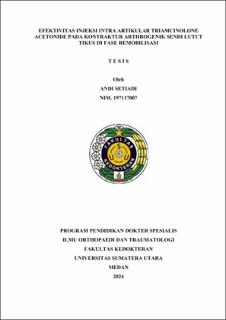| dc.description.abstract | Introduction Joint contracture, defined as a limitation of passive movement in a joint, can
result from long-term immobilization which leads to significant disability. Triamcinolone
Acetonide (TA), a synthetic glucocorticoid, is known for its anti-inflammatory effects and has
been widely used for joint disorders in humans. This study aims to investigate the effectiveness
of TA injections in reducing arthrogenic contracture in rat knee joints during remobilization.
Method This experimental research utilized a posttest only control group design, conducted
from September to October 2023 at the Integrated Laboratory of the Faculty of Pharmacy,
Universitas Sumatera Utara. Adult male Wistar rats aged 8 weeks, weighing 200-300 grams,
were divided into control, saline (NaCl 0.9%), and TA injection groups. Joint immobilization
was induced for 4 weeks to simulate contracture, followed by remobilization and treatment
interventions.
Results Preliminary findings indicate significant variations in passive range of motion
(PROM), microscopic observations of joint capsule length, width, and cell count per field view
across groups. Detailed results and statistical analysis will provide insight into TA's efficacy.
Discussion The discussion likely revolves around the comparison of TA's anti-inflammatory
and anti-fibrotic effects on joint mobility and histological changes within the joint capsule
against control and saline-treated groups. The implications for clinical practice, potential for
reducing contracture during rehabilitation, and limitations of the study are considered.
Conclusion While the full results and conclusion are not covered in the summary, the study
anticipates demonstrating TA's effectiveness in improving joint mobility and reducing the
progression of arthrogenic contracture during the remobilization phase, with potential
applications in clinical settings. | en_US |


